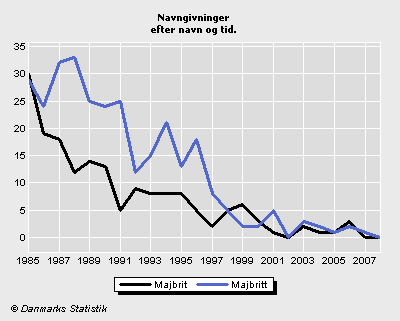Majbritt
The girls' name Majbritt is the one that has been authorised by the Nation Social Appeals Board in the most numerous different spellings. It is also a rather complicated name. This is because it is not only a compound name – made up of two different independent names – but the first element of the compound itself has a complicated history.
On the list published by the National Social Appeals Board we find the following variant forms: Mai-Brit, Mai-Britt, Maibrith, Maibritt, Maj-Brit, Maj-Britt, Majabrith, Majbrit, Majbrith, Majbritt, Majbritte, May-Britt, Maybrit, Maybrith and Maybritt.
This means that there are a total of 16 authorised spellings. The most frequently occurring of these is Majbritt, and, according to Statistics Denmark, on 1st January 2010 there were 2,651 Danes who bore this form as their first forename. In addition there are many who bore it as a second or third forename – in 2005 this was the case with almost 800 individuals, as can be seen from the search base Danskernes Navne.
Altogether there are about 9,000 bearers of the name in its different variants. Almost all of these variants, however, were most popular in the 60s and 70s and the number of new bearers has been diminishing rapidly in the course of the last quarter of a century. In recent years hardly any small girls have received this name.

Statistic Denmark's graph showing the popularity of the forms Majbrit and Majbritt, two of the most common forms.
The popularity of the name thus follows the same tendency as the second element in the name – Britt – while the first element – Maj – together with Maja would in fact seem to have surpassed the old popularity of Majbritt.
A complicated origin
The second element in the name, Brit(t), is not particularly complicated. It is a widespread hypocoristic form of Brigitte, a development from Brigida, which is the latinised form of the name of the Celtic saint Brighid, which probably means 'the high one'.
The situation with Maj is more complicated. Not only does it appear with the variants Mai and May – and via English also with Mae – but there are several possible explanations, and in the individual cases it can be practically impossible to say which of the explanations is the correct one.
Most people probably associate the name with the month of May and this is probably the most frequent reason for selecting the name at the present time.
Another possibility is that it is a hypocoristic form of the name Mai, and the month of May was originally itself called after the Graeco-Roman goddess Maia 'the little mother', who was associated with spring and fertility.
A third possibility is that it is a hypocoristic form of Maria, the biblical name that has been extremely popular since the medieval period. In the Hebrew language this name can mean ‘the loved one' or perhaps 'lady' or 'prophetess'. In Swedish (and Frisian) Maria has acquired the hypocoristic form Maja, and Maja has then been further shortened to Maj.
